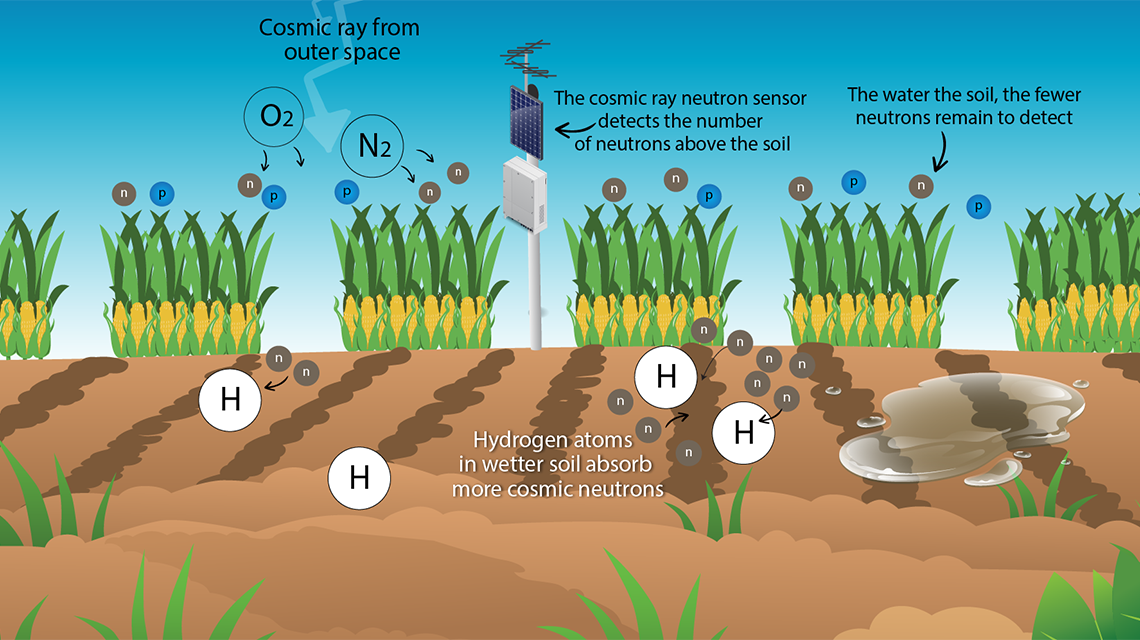Neutrons propelled to Earth by cosmic rays from space are helping scientists in more than 25 countries to measure water in soil and help farmers save water and adapt to climate change. With a cosmic ray neutron sensor, scientists track these fast-moving neutrons in the atmosphere to determine how much water is already in the soil and when the farmer needs to add water to help crops thrive even in harsh climate conditions.
“My country is affected by climate change and drought,” said Imad-eldin A. Ali Babiker, an agricultural scientist at Sudan’s Agricultural Research Corporation in the Ministry of Agriculture and Forestry and a participant in one of several training courses supported by the IAEA in collaboration with the Food and Agriculture Organization of the United Nations (FAO) and other international organizations. “Training to use the cosmic ray neutron sensor has opened a new window for us to manage soil water content.”
The cosmic ray neutron sensor is a device that can measure moisture levels by detecting fast moving neutrons in the soil and in the air just above the soil (see How the cosmic ray neutron sensor works). It is faster, more portable and can more easily cover an area compared to traditional methods.
Since 2013, scientists at the Joint FAO/IAEA Division of Nuclear Techniques in Food and Agriculture have been testing and calibrating the cosmic ray neutron sensor, including a mobile version that comes in the form of a backpack. “Studies in crops like maize have shown that scheduling irrigation using the cosmic ray neutron sensor can save up to 100 mm of irrigation water each season — which is equivalent to 1 million litres of water per hectare and a huge amount in water-scarce regions — by optimizing how much water a farmer needs to use and when, while even improving crop yields,” said Ammar Wahbi, a soil water scientist in the Joint FAO/IAEA Division.
More than 300 scientists worldwide have been trained to use this neutron-sensing technology in courses designed to develop technical skills and the ability to apply the skills for decision making. The courses include instruction on how to use the AquaCrop simulation model, a software developed by the FAO to accurately simulate expected crop growth and water consumption under different scenarios.
In Iraq, these courses have helped scientists identify crops suited to the country’s climate conditions, said Ameerah Hanoon Atiyah, a scientist from Iraq’s Ministry of Science and Technology. “Looking at different scenarios supports decision making; for instance, which crops to plant to better manage scarce water resources.”
Traditional methods capture information only a few centimetres surrounding the probe, which makes large-scale surveys both time and labour intensive. The cosmic ray neutron sensor, in contrast, can provide results immediately for a 20-hectare area without disturbing the soil and the vast web of interrelated organisms and structures the soil contains.
“Traditional methods involve taking several soil samples, drying them in an oven for 48 hours and measuring the weight difference between the original and the dried samples,” explained Trenton Franz, a hydrogeophysicist from the University of Nebraska-Lincoln and an expert involved in the FAO/IAEA training courses.
As of 2018, more than ten national and regional research and technical cooperation projects related to cosmic ray neutron sensors are planned or ongoing in 15 countries. Through these projects, experts have received or are going to receive their own devices to apply what they learn through the training courses.
Looking at different scenarios supports decision making; for instance, which crops to plant to better manage scarce water resources.





